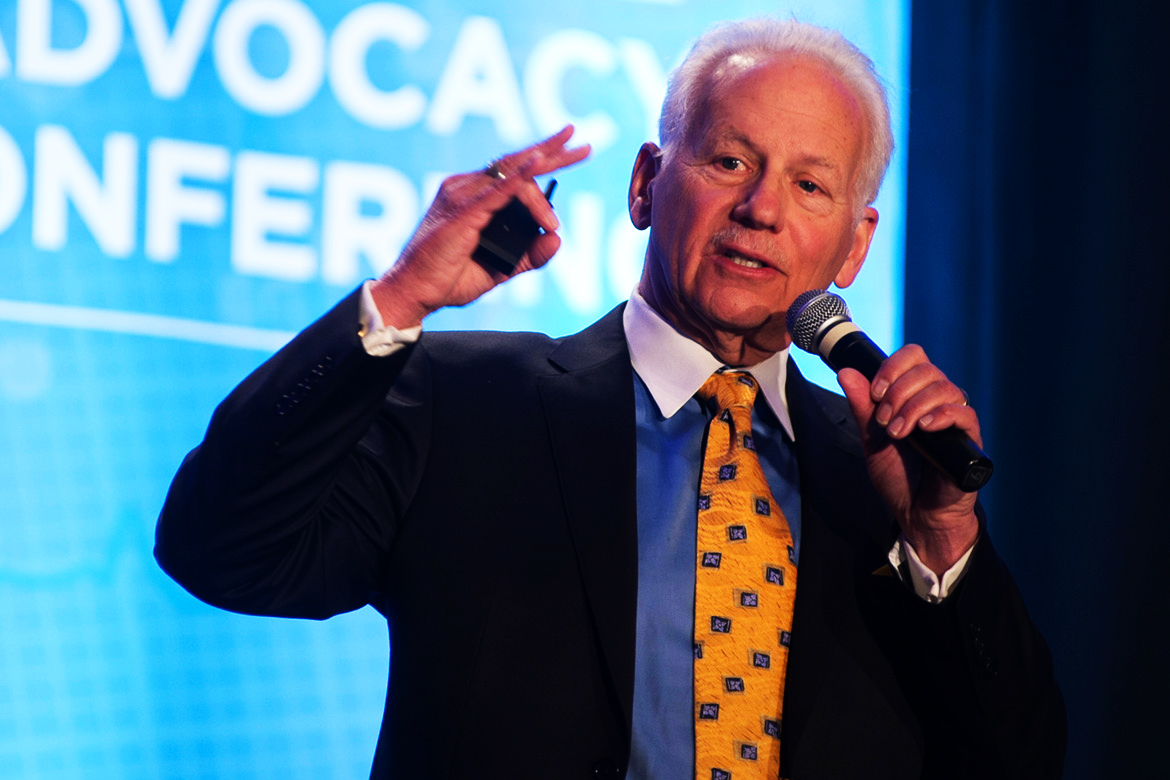Committing to change is one thing, but seeing that commitment through to actuality is a difficult task. Whether taking your issues to Capitol Hill or making changes in your practice, how can you stay the course and do what needs to be done? Ken Adelman, former ambassador and arms control director for former President Ronald Reagan, spoke last week to physician leaders in Washington, D.C., about how the Cold War was won and what it takes to enact meaningful change.
Making change happen
Adelman addressed physicians at the 2016 National Advocacy Conference who were preparing to meet with their lawmakers about key issues in health care, from combatting the opioid epidemic to advancing telemedicine to improving electronic health records. He offered insights for physicians who are advocating for important changes, whether on the Hill, in their communities or in their practices.
“You are real leaders in your field,” Adelman said. “What you’re leading on now—improving wellness for patients in heart disease and diabetes and innovation in medical schools and joy in the practice of medicine—are important.”
How to achieve your goal
Adelman offered a five-step strategy for making sure that the changes that you want are made known and that those changes actually happen. At a small house in Reykjavik, Iceland, Reagan met with then-Soviet leader Mikhail Gorbachev to determine the fate of the nuclear arms race and the Cold War. Here’s how he did it:
Make no small plans
“Think big,” Adelman said. When a political advisor asked Reagan why he wanted to be president of the United States, he said firmly, “To end the cold war.” When asked how he would do it, Reagan said, “We win, they lose.”
If you’re seeking change, “be very firm in what you want,” Adelman said. “Be very nice, personally … be willing to sit down [with those who can make the changes], but also be willing to stand up for what you need.”
Work out how to get from here to there
“It took us about nine months to plan that first summit [to try to end the Cold War],” Adelman said. Reagan had the plan in place and knew the components to make it happen.
Trust the team
“Have a group that you can deal with that is reliable and carefully chosen—and then trust them,” Adelman said. Once Reagan and Gorbachev had discussed their initial talking points, they then trusted their teams, letting them into the room to negotiate.
Don’t accept defeat
The summit in Reykjavik went into overtime, the only one in history to do so. After the initial conversations with the Russians were unsuccessful in the ultimate goal, “Reagan came to us and said, ‘I’m going to go down and talk to Gorbachev one more time, and that’s it,’” Adelman said. “[Reagan] said he told Nancy he’d be home for dinner.”
Though that final meeting still did not result in the end of the Cold War, Reagan didn’t accept that as the final outcome. The initial word about the summit was that it had been a disaster and that the Russians would never back down. But to Reagan, the goal still was clear—the Cold War had to end.
When things don’t go according to plan, it doesn’t mean that the game is over, Adelman said. It is important to treat defeat not as the end of the attempt but just another road block on the road to the goal.
Stay the course
Seven months after the summit, Reagan was scheduled to give a speech in Berlin. He had one thing he wanted to say. It was removed from the speech by everyone, and he kept putting it back in. Finally the day came, and he stood in front of the Berlin Wall and delivered the most remembered speech of his presidency ending with, “Mr. Gorbachev, open this gate …. Mr. Gorbachev, tear down this wall.” In November 1989, the wall came down.
Leading the way
That weekend in Reykjavik was “an example of great leadership,” Adelman said. “The type that physicians and the AMA are showing … the type of leadership we need in America today. Pitch hard when you’re taking your issues to the Hill.”
AMA President Steven J. Stack, MD, noted that physician leadership and persistence has made real changes for the nation’s patients and the medical profession alike. “This time last year,” he reminded attendees, “we were trying to get the sustainable growth rate [formula] repealed—and now it’s gone.”
Even if you aren’t meeting with your members of Congress, you can help lead the way on important changes for your patients and your practice. Among the actions you can take now:
- Visit BreakTheRedTape.org, the AMA’s grassroots campaign website, to advocate for ways to solve medicine’s regulatory and legislative challenges. The Medicare Access and CHIP Reauthorization Act will see its first draft rule this spring. Make sure your voice is part of the plan.
- Learn five steps to help address the nation’s opioid epidemic in your community, and access resources that can help you make a big difference.
- Learn how to transform your practice to increase your practice’s sustainability and improve patient care using the AMA’s STEPS Forward™ modules.




